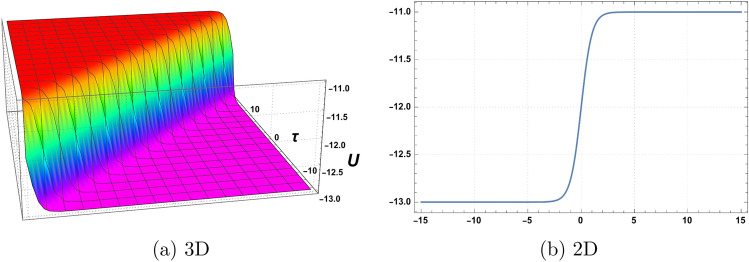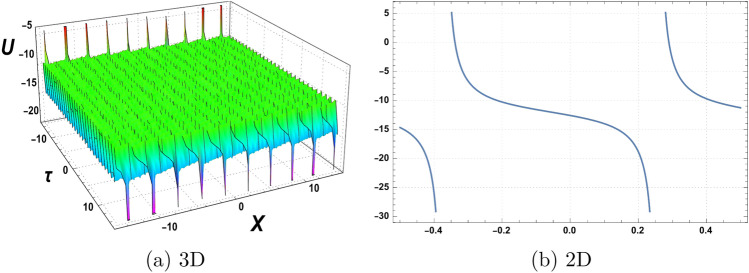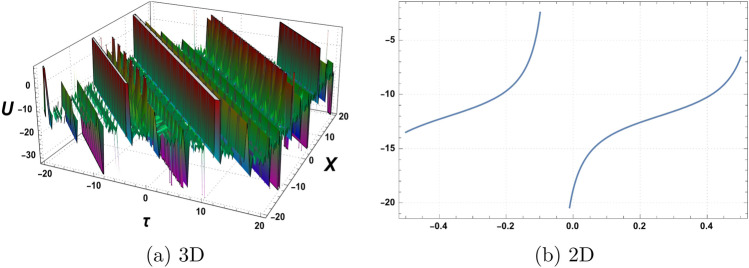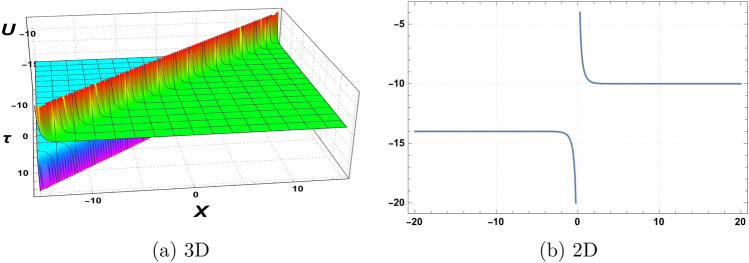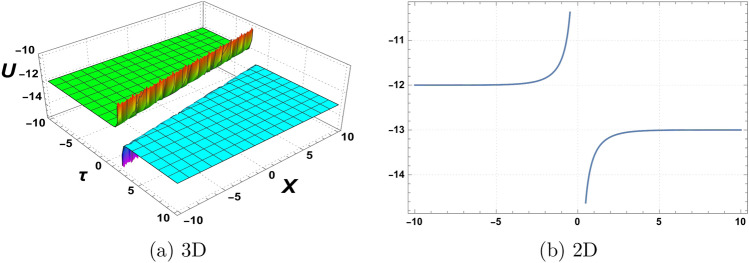Abstract
Nonlinear chains of atoms (NCA) are complex systems with rich dynamics, that influence various scientific disciplines. The lie symmetry approach is considered to analyze the NCA. The Lie symmetry method is a powerful mathematical tool for analyzing and solving differential equations with symmetries, facilitating the reduction of complexity and obtaining solutions. After getting the entire vector field by using the Lie scheme, we find the optimal system of symmetries. We have converted assumed PDE into nonlinear ODE by using the optimal system. The new auxiliary scheme is used to find the Travelling wave solutions, while graphical behaviour visually represents relationships and patterns in data or mathematical models. The multiplier method enables the identification of conservation laws, and fundamental principles in physics that assert certain quantities remain constant over time.
Subject terms: Mechanical engineering, Mathematics and computing, Applied mathematics, Computational science, Software
Introduction
The Lie symmetry analysis approach1–12 has many applications in different fields, including physics, engineering, and mathematical modelling. It can be used to study a wide range of nonlinear PDEs, including those that are difficult to solve using other methods. Additionally, this approach provides a powerful tool for developing new theories and models that improve our understanding of complex physical systems. Overall, the Lie symmetry analysis approach is a valuable tool for studying nonlinear PDEs and has many significant applications in different branches of science and engineering.
The Lie symmetry analysis approach13–23 is a powerful method used in the study of nonlinear PDEs. It is based on the concept of Lie groups and Lie algebras, which are mathematical structures that describe the symmetries of a system. The Lie symmetry analysis approach involves transforming a given PDE into an equivalent system of ODEs using a Lie group transformation. This transformation is constructed from a set of symmetry generators that preserve the form of the original PDE. Once the PDE is transformed into an equivalent system of ODEs, it is possible to use various analytical and numerical methods to solve the system and obtain the solution to the original PDE. Additionally, the Lie symmetry analysis approach can be used to identify the conservation laws that govern the physical behaviour of the system under study. These conservation laws provide important insights into the underlying physical mechanisms responsible for the observed behaviour of the system.
Nonlinear PDEs24–27 play a critical role in mechanical engineering by modelling complex phenomena such as stress and deformation in materials, fluid flow, and heat transfer. Unlike linear PDEs, which can be solved analytically in many cases, nonlinear PDEs require numerical or approximate methods to solve due to their complex nature. The use of nonlinear PDEs is essential in the design and optimization of mechanical systems such as turbines, engines, and aircraft. They also provide a framework for predicting the behaviour of materials under different conditions, such as high temperatures, high pressure, and rapid deformation. By incorporating nonlinear PDEs into mechanical engineering models, engineers can improve the accuracy of their designs and ensure that their systems are safe, reliable, and efficient.
Nonlinear chains of atoms28–34 have a wide range of applications in mechanical engineering, particularly in the study of materials science and solid mechanics. These models provide valuable insights into the behaviour of materials at the atomic level, enabling the design of high-performance materials for various applications. Applications of nonlinear chains of atoms include the study of thermal conductivity in materials, investigating the deformation and fracture mechanisms of materials under various loading conditions, and studying the dynamics of crystals, such as the propagation of waves and the formation of defects. Nonlinear chains of atoms models are crucial in understanding the behaviour of materials under extreme conditions and can inform the design of materials for high-performance applications, leading to the development of new materials with enhanced mechanical and thermal properties.
The analysis of nonlinear chains of atoms using Lie symmetry analysis and conservation laws is motivated by the desire to uncover the fundamental principles that govern the behaviour of these complex systems and gain a deeper understanding of their dynamics and properties. While there has been extensive research on nonlinear chains of atoms, there exist research gaps that can be addressed through the application of Lie symmetry analysis and conservation laws. These gaps include a need for comprehensive studies on the symmetries and conservation laws specific to nonlinear atomic chains, exploration of multiscale behaviour, and bridging the gap between theoretical analysis and practical applications. By addressing these research gaps, researchers can contribute to a more comprehensive understanding of nonlinear chains of atoms and pave the way for advancements in fields such as materials design, nanotechnology, and engineering applications.
The new auxiliary method35, 36 is a recently proposed method for solving challenging nonlinear PDEs. This method involves introducing an auxiliary variable and constructing a system of coupled equations involving both the original variables and the auxiliary variable. The resulting system of equations can be solved using numerical methods to obtain the solution to the original PDE. The new auxiliary method can handle highly nonlinear PDEs that are difficult to solve using other numerical methods, such as the finite difference approach or the finite element scheme. Additionally, this method can be used to obtain exact solutions to certain types of nonlinear PDEs, reducing the computational cost required to solve some types of nonlinear PDEs. Overall, the new auxiliary method is a promising tool for solving challenging nonlinear PDEs in various fields, including physics, engineering, and mathematical modelling.
Conservation laws of nonlinear PDEs37–40 are essential concepts that relate to the principle of conservation of physical quantities like mass, energy, and momentum. These laws are expressed in terms of PDEs and have crucial importance in various fields, including engineering, physics, and mathematical modelling. They provide a mathematical framework to predict the behaviour of complex physical systems accurately and develop new theories and models to improve our understanding of the underlying physical mechanisms. Furthermore, conservation laws play a vital role in the design and analysis of physical systems and the development of numerical methods for solving challenging nonlinear PDEs, making them fundamental concepts in the study of nonlinear PDEs.
The layout of this research is presented as. Formation of supposed model is described in section 2. NAM and multiplier method are explained in section 3. technique and multiplier scheme are presented in section 2. Lie group analysis method is applied on supposed model and entire vector field is described in section 4. Optimal system, similarity reduction, wave solutions, and graphics are represented in section 5. Discussion of graphs and conservation laws of assumed model are described in section 6 and 7 respectively. The conclusions are stated in Sect. 8.
Formation of model
The Hamiltonian of the system is Foroutan et al.41:
| 1 |
where m is the mass of the atom, stands for nonlinear potential and dot indicates for derivative w.r.t time. We consider and the subsequent potential:
| 2 |
where is relative displacement among atom and . The index i shows the distinct interactions via the particles. We omit our focus on the first and second neighbours. From Eqs. (1) and (2) through Hamiltonian equations which are
which gives us the equation of motion;
| 3 |
In Hamiltonian’s equations, stands for generalized momentum. Assuming that the (inter-atom spacing) is small enough so that the continuum limit is reached, we substitute . Then
| 4 |
and
| 5 |
hence, Eq. (3) can be supposed as Foroutan et al.42
| 6 |
with the subsequent constants;
| 7 |
here in this paper, we will find out wave solutions and conservation laws for nonlinear Eq. (6) with the use of an appropriate transformation method.
Preliminaries
New auxiliary approach
Assuming the general form of partial PDE is of the form:
| 8 |
where is the time part and is the spatial part and is the dependent variable. We will follow the following steps.
- Step 2 Assume the general solution for Eq. (10) is of the form
in the above solution, the ’s are constants and we will fine later and the 1st ODE satisfied .11 12 Step 3 In this step, we will use the balancing scheme to execute the value of N. For this, we have to compare the highest-order linear and nonlinear terms to find the value of N.
Step 4 Getting the coefficients of the powers of () by Eqs. (8), (11), and (12). Then collecting the terms of the same power and put them equal to zero which gives us a system of algebraic equations. After solving this system of equations by Maple.
Step 5 Finally we will get the different family of solutions for Eq. (12) of the form:
- Case 1 When and
13 14 - Case 2 When and
15 16 - Case 3 When and and
17 18 - Case 4 When , and
19 20 - Case 5 When and
21 22 - Case 6 When and
23 24 - Case 7 When , and
25 26 - Case 8 When and
27 - Case 9 When
28 - Case 10 When , and
29 - Case 11 When , and
30 - Case 12 When
31 - Case 13 When
32 - Case 14 When
33 - Case 15 When
34 - Case 16 When ,
35 - Case 17 When
36
Multiplier approach
Supposing the Eq. (8) and applying the following steps below:
- Defining the total differential as:
37 - Defining the Euler operator as below:
38 - The purpose of of the Eq. (8):
for some function .40
Lie group analysis of Eq. (6)
Here, we are supposing the Lie approach for assumed Eq. (6). Now, suppose the one-parameter Lie group of infinitesimal transformations on given by
and is a Small parameter. The associated Lie algebra of infinitesimal symmetries is generated by vector fields
| 42 |
Equation (42) creates a symmetry of Eq. (6), and satisfy the Lie group conditions
The fourth prolongation for can be written as:
| 43 |
furthermore, we have
| 44 |
Let , where can be written as:
Substituting the values of which gives us the following vectors:
| 45 |
We see that
Optimal system
In this section, we observe that from the obtained vector field Eq. (45), the forms an abelian algebra. So we can use the (42) and get:
| 46 |
Similarity reduction of Eq. (6)
Here, we will find the similarity variables and analytical results for Eq. (6).
Using the vector , we get the new variable
| 47 |
putting the (47) into Eq. (6), which gives us
| 48 |
where and are integration constants.
Using the vector , we get the new variable
| 49 |
putting the (49) into Eq. (6), which gives us
| 50 |
Application of new auxiliary method
Here, we aim to construct the wave patterns for Eq. (6) from Eq. (50) with the use of the proposed technique. Using the balancing method and we obtain . Using the value of in (11) and we have
| 51 |
We have to put Eq. (51) into Eq. (50) and we get the system of the equation after comparing the coefficients of . With the use of Maple, we solved the obtained system of equations and got the following results.
| 52 |
Using Eq. (52) into Eq. (51) gives us the following set of solutions.
| 53 |
Where is an arbitrary constant.
- Case 1 When and
54 55 - Case 2 When and
56 57 - Case 3 When and and
58 59 - Case 4 When , and
60 61 - Case 5 When and
62 63 - Case 6 When and
64 65 - Case 7 When , and
66 67 - Case 8 When and
68 - Case 9 When
69 - Case 10 When , and
70 - Case 11 When , and
71 - Case 12 When
72 - Case 13 When
73 - Case 14 When
74 - Case 15 When
75 - Case 16 When ,
76 - Case 17 When
where is given according to.77
Graphics and discussion
A graphical representation of obtained solutions is discussed here in this section. By using the new auxiliary method we have constructed the analytical behaviour of the considered model in the form of trigonometric functions, hyperbolic trigonometric functions, and exponential, and algebraic-type results. The graph of the tangent function is periodic with a period of and has vertical asymptotes at odd multiples of . As approaches these vertical asymptotes, the tangent function approaches positive or negative infinity depending on the direction of the approach. The graph of the cotangent function is also periodic with a period of and has horizontal asymptotes at even multiples of . As approaches these horizontal asymptotes, the cotangent function approaches zero. We have plotted the behaviour of some obtained results. Figure 1 shows the graphical behavior of for the choice of parameters , , , , ,, . Figure 2 represent the behaviour of for the choice of parameters , , , , ,, . Figure 3 shows the Graphics of for the choice of parameters , , , , ,, . Figure 4 shows the Graphics of for the choice of parameters , , , , ,, . Figure 5 represent the behaviour of for the choice of parameters , , , , ,, . The behaviour of shows Singularities exist in exponential functions due to their intrinsic nature of rapid and unbounded growth or decay. The exponential function, typically represented as ,where e is Euler’s number approximately equal to 2.71828,captures the exponential growth or decay phenomenon. However, certain values of result in problematic behaviour or undefined outcomes. When approaches positive or negative infinity, the exponential function exhibits an asymptotic behaviour, approaching infinity or zero, respectively, without reaching a definite value. These instances represent singularities where the exponential function becomes indeterminate or encounters difficulties in providing a well-defined result. These singularities in the exponential function highlight the inherent limitations and special characteristics associated with exponential growth or decay processes.
Figure 1.
Graphics of (a) versus time component for the choice of parameters , , , , , and (b) considering at .
Figure 2.
Graphics of (a) versus time component for the choice of parameters , , , , ,, and (b) considering at .
Figure 3.
Graphics of (a) versus time component for the choice of parameters , , , , ,, and (b) considering at .
Figure 4.
Graphics of (a) versus time component for the choice of parameters , , , , ,, and (b) considering at .
Figure 5.
Graphics of (a) versus time component for the choice of parameters , , , , ,, and (b) considering at .
Conservation laws
In this portion, we will construct the conservation laws by multiplier approach for Eq. (6). We obtain the determinant equation for by Eq. (41).
| 78 |
Using Eq. (38), we can write the Euler operator is of the form
| 79 |
defining the total derivative operators and from Eq. (37).
| 80 |
computing Eq. (78) and we obtain the following multipliers and conservation laws:
| 81 |
by Eqs. (40) and (81), The following conservation laws are found
| 82 |
Using Eq. (82) and we get the following two cases of conservation laws.
- Case 1 For , then , we get the following fluxes:
83 - Case 2 For , then , we get the following fluxes:
84
Conclusion
In this research, nonlinear chains of atoms(NCA) are studied. NCA play a crucial role in materials design and fabrication, enabling the development of advanced materials with tailored properties. The unique structural arrangements and interactions of nonlinear chains of atoms influence the mechanical, electrical, and optical properties of materials, which are essential for designing innovative technologies in fields such as nanotechnology, optoelectronics, and energy systems. Also, NCA are of great interest in the study of dynamical systems and nonlinear phenomena. They provide valuable insights into the behaviour of complex systems, allowing for the analysis and modelling of intricate dynamics observed in areas like physics, biology, and control theory. The Lie symmetry method and NAM enhances existing techniques, offering additional insights, improved accuracy, or simplified computations. Travelling wave solutions describe wave-like behaviour propagating through systems, while graphical behaviour provides visual representations of relationships and patterns in data or mathematical models. The multiplier method allows for the identification of conservation laws, which are fundamental principles in physics that state certain quantities remain constant over time. Understanding conservation laws and utilizing mathematical techniques such as the Lie symmetry method, travelling wave solutions, and graphical analysis contributes to a deeper understanding of nonlinear chains of atoms and their dynamics.
Acknowledgements
The first author,Muhammad Junaid U Rehman, is a doctoral candidate in the Interdisciplinary Doctoral School at the Lodz University of Technology, Poland. This work has been supported by the Polish National Science Centre, Poland under the Grant OPUS 18 No.2019/35/B/ST8/00980.
Author contributions
M.J.: Conceptualization, Methodology, Investigation, Software, Writing—original draft. G.K.: Supervision, Software, Validation. J.A.: Visualization, Investigation, Reviewing the original draft.
Data availability
All data that support the findings of this study are included within the article.
Competing Interest
The authors declare no competing interests.
Footnotes
Publisher's note
Springer Nature remains neutral with regard to jurisdictional claims in published maps and institutional affiliations.
References
- 1.Riaz MB, Atangana A, Jhangeer A, Junaid-U-Rehman M. Some exact explicit solutions and conservation laws of Chaffee-Infante equation by Lie symmetry analysis. Phys. Scr. 2021;96(8):084008. doi: 10.1088/1402-4896/ac0074. [DOI] [Google Scholar]
- 2.Kumar S, Jadaun V, Ma WX. Application of the Lie symmetry approach to an extended Jimbo-Miwa equation in (3+ 1) dimensions. Eur. Phys. J. Plus. 2021;136(8):1–30. doi: 10.1140/epjp/s13360-021-01813-1. [DOI] [Google Scholar]
- 3.Jadaun V. Soliton solutions of a (3+ 1)-dimensional nonlinear evolution equation for modelling the dynamics of ocean waves. Phys. Scr. 2021;96(9):095204. doi: 10.1088/1402-4896/ac0031. [DOI] [Google Scholar]
- 4.Jadaun, V. Lie symmetry approach to study the impact of a bulge on hemodynamics in an elastic-compliant artery. Math. Methods Appl. Sci. (2023).
- 5.Jhangeer A, Hussain A, Junaid-U-Rehman M, Khan I, Baleanu D, Nisar KS. Lie analysis, conservation laws, and travelling wave structures of nonlinear Bogoyavlenskii-Kadomtsev-Petviashvili equation. Results Phys. 2020;19:103492. doi: 10.1016/j.rinp.2020.103492. [DOI] [Google Scholar]
- 6.Noether E. Invariante variations probleme. Nachr. König. Ges. Wiss. Gött. Math.-Phys. Kl. Heft. 1918;2:235–257. [Google Scholar]
- 7.Kara AH, Mahomed FM. Noether-type symmetries and conservation laws via partial Lagrangians. Nonlinear Dyn. 2006;45:367–383. doi: 10.1007/s11071-005-9013-9. [DOI] [Google Scholar]
- 8.Freire IL. New conservation laws for inviscid Burgers equation. Comput. Appl. Math. 2012;31:559–567. doi: 10.1590/S1807-03022012000300007. [DOI] [Google Scholar]
- 9.Torrisi M, Tracina R. Quasi self-adjointness of a class of third-order nonlinear dispersive equations. Nonlinear Anal. Real World Appl. 2013;14:1496–1502. doi: 10.1016/j.nonrwa.2012.10.013. [DOI] [Google Scholar]
- 10.Gandarias ML, Bruzon MS. Some conservation laws for a forced KdV equation. Nonlinear Anal. Real World Appl. 2012;13:2692–2700. doi: 10.1016/j.nonrwa.2012.03.013. [DOI] [Google Scholar]
- 11.Riaz MB, Baleanu D, Jhangeer A, Abbas N. Nonlinear self-adjointness, conserved vectors, and travelling wave structures for the kinetics of phase separation dependent on ternary alloys in iron (Fe-Cr-Y (Y= Mo, Cu)) Results Phys. 2021;25:104151. doi: 10.1016/j.rinp.2021.104151. [DOI] [Google Scholar]
- 12.Riaz M B, Awrejcewicz J, Jhangeer A, Junaid-U-Rehman M. A variety of new traveling wave packets and conservation laws to the nonlinear low-pass electrical transmission lines via lie analysis. Fractal Fract. 2021;5:170. doi: 10.3390/fractalfract5040170. [DOI] [Google Scholar]
- 13.Rogers C, Schief WK. BäCklund and Darboux Transformation Geometry and Modern Applications in Soliton Theory. Cambridge University Press; 2002. [Google Scholar]
- 14.Bluman GW, Cheviakov AF, Anco SC. Applications of Symmetry Methods to Partial Differential Equations. Springer; 2000. [Google Scholar]
- 15.Ibragimov NH. A new conservation theorem. J. Math. Anal. Appl. 2007;333:311–28. doi: 10.1016/j.jmaa.2006.10.078. [DOI] [Google Scholar]
- 16.Olver PJ. Application of Lie Groups to Differential Equations. Springer-Verlag; 1993. [Google Scholar]
- 17.Ovsiannikov LV. Group Analysis of Differential Equations. Academic; 1982. [Google Scholar]
- 18.Hirota R. Direct Methods in Soliton Theory. Springer; 2004. [Google Scholar]
- 19.Bluman GW, Kumei S. Symmetries and Differential Equations. Springer-Verlag; 1989. [Google Scholar]
- 20.Riaz MB, Jhangeer A, Abualnaja KM, Junaid-U-Rehman M. Conserved quantities and travelling wave profiles to the nonlinear transmission line via Lie group analysis. Phys. Scr. 2021;96(10):104013. doi: 10.1088/1402-4896/ac0dfe. [DOI] [Google Scholar]
- 21.Hussain A, Junaid-U-Rehman M, Jabeen F, Khan I. Optical solitons of NLS-type differential equations by the extended direct algebraic method. Int. J. Geom. Methods Modern Phys. 2022;19(05):2250075. doi: 10.1142/S021988782250075X. [DOI] [Google Scholar]
- 22.Hussain, A., Anjum, A., Junaid-U-Rehman, M., Khan, I., Sameh, M. A. & Al-Johani, A. S. Symmetries, optimal system, exact and soliton solutions of (3 + 1)-dimensional Gardner-KP equation. J. Ocean Eng. Sci. (2022).
- 23.Riaz MB, Awrejcewicz J, Jhangeer A, Junaid-U-Rehman M, Hamed YS, Abualnaja KM. Some new wave profiles and conservation laws in a Pre-compressed one-dimensional granular crystal by Lie group analysis. Eur. Phys. J. Plus. 2022;137(3):401. doi: 10.1140/epjp/s13360-022-02619-5. [DOI] [Google Scholar]
- 24.Seadawy AR, Rizvi ST, Ali I, Younis M, Ali K, Makhlouf MM, Althobaiti A. Conservation laws, optical molecules, modulation instability, and Painlevé analysis for the Chen-Lee-Liu model. Opt. Quantum Electron. 2021;53(4):1–15. doi: 10.1007/s11082-021-02823-0. [DOI] [Google Scholar]
- 25.Seadawy AR, Rizvi STR, Ahmad S, Younis M, Baleanu D. Lump, lump-one stripe, multi-wave and breather solutions for the Hunter-Saxton equation. Open Phys. 2021;19(1):1–10. doi: 10.1515/phys-2020-0224. [DOI] [Google Scholar]
- 26.Seadawy AR, Ahmed HM, Rabie WB, Biswas A. Chirp-free optical solitons in fibre Bragg gratings with dispersive reflectivity having polynomial law of nonlinearity. Optik. 2021;225:165681. doi: 10.1016/j.ijleo.2020.165681. [DOI] [Google Scholar]
- 27.Jhangeer A, Hussain A, Junaid-U-Rehman M, Baleanu D, Riaz MB. Quasi-periodic, chaotic, and travelling wave structures of modified Gardner equation. Chaos Solitons Fractals. 2021;143:110578. doi: 10.1016/j.chaos.2020.110578. [DOI] [Google Scholar]
- 28.Peyrard M, Remoissenet M. Solitonlike excitations in a one-dimensional atomic chain with a nonlinear deformable substrate potential. Phys. Rev. B. 1982;26(6):2886. doi: 10.1103/PhysRevB.26.2886. [DOI] [Google Scholar]
- 29.Fang X, Wen J, Yin J, Yu D. Wave propagation in nonlinear metamaterial multi-atomic chains based on homotopy method. AIP Adv. 2016;6(12):121706. doi: 10.1063/1.4971761. [DOI] [Google Scholar]
- 30.Braun OM, Kivshar YS. The Frenkel-Kontorova Model: Concepts, Methods, and Applications. Springer; 2004. p. 475. [Google Scholar]
- 31.Kaur L, Wazwaz AM. Einstein’s vacuum field equation: Painlevé analysis and Lie symmetries. Waves Rand. Compl. Media. 2021;31(2):199–206. doi: 10.1080/17455030.2019.1574410. [DOI] [Google Scholar]
- 32.Khan MH, Wazwaz AM. Lump, multi-lump, cross kinky-lump and manifold periodic-soliton solutions for the (2 + 1)-D Calogero-Bogoyavlenskii-Schif equation. Heliyon. 2020;6(4):03701. doi: 10.1016/j.heliyon.2020.e03701. [DOI] [PMC free article] [PubMed] [Google Scholar]
- 33.Khater AH, Callebaut DK, Seadawy AR. General soliton solutions for nonlinear dispersive waves in convective type instabilities. Phys. Sci. 2006;74:384–393. doi: 10.1088/0031-8949/74/3/015. [DOI] [Google Scholar]
- 34.Kumar S, Kumar D, Kumar A. Lie symmetry analysis for obtaining the abundant exact solutions, optimal system and dynamics of solitons for a higher-dimensional Fokas equation. Chaos Solitons Fractals. 2021;142:110507. doi: 10.1016/j.chaos.2020.110507. [DOI] [Google Scholar]
- 35.Jarad F, Jhangeer A, Awrejcewicz J, Riaz MB, Junaid-U-Rehman M. Investigation of wave solutions and conservation laws of generalized Calogero-Bogoyavlenskii-Schiff equation by group theoretic method. Results Phys. 2022;37:105479. doi: 10.1016/j.rinp.2022.105479. [DOI] [Google Scholar]
- 36.Khan MA, Akbar MA, binti Abd Hamid NN. Travelling wave solutions for space-time fractional cahn Hilliard equation and space-time fractional symmetric regularized long-wave equation. Alex. Eng. J. 2021;60:1317–24. doi: 10.1016/j.aej.2020.10.053. [DOI] [Google Scholar]
- 37.Ablowitz, M. J. & Clarkson, P. A. Solitons, nonlinear evolution equations, and inverse scattering, in Vol. 149 of London Mathematical Society Lecture Note Series (Cambridge University Press, 1991).
- 38.Naz R, Mahomed FM, Mason DP. Comparison of different approaches to conservation laws for some partial differential equations in fluid mechanics. Appl. Math. Comput. 2008;205:212–30. [Google Scholar]
- 39.Bruzón MS, Gandarias ML, Ibragimov NH. Self-adjoint sub-classes of generalized thin film equations. J. Math. Anal. Appl. 2009;357:307–13. doi: 10.1016/j.jmaa.2009.04.028. [DOI] [Google Scholar]
- 40.Ibragimov NH. Nonlinear self-adjointness and conservation laws. J. Phys. A. 2011;44:432002. doi: 10.1088/1751-8113/44/43/432002. [DOI] [Google Scholar]
- 41.Foroutan M, Zamanpour I, Manafan J. Applications of IBSOM and ETEM for solving the nonlinear chains of atoms with long-range interactions. Eur. Phys. J. Plus. 2017;132(10):1–18. doi: 10.1140/epjp/i2017-11681-7. [DOI] [Google Scholar]
- 42.Ahmed S, Seadawy AR, Rizvi ST. Study of breathers, rogue waves, and lump solutions for the nonlinear chains of atoms. Opt. Quantum Electron. 2022;54(5):320. doi: 10.1007/s11082-022-03732-6. [DOI] [Google Scholar]
Associated Data
This section collects any data citations, data availability statements, or supplementary materials included in this article.
Data Availability Statement
All data that support the findings of this study are included within the article.



